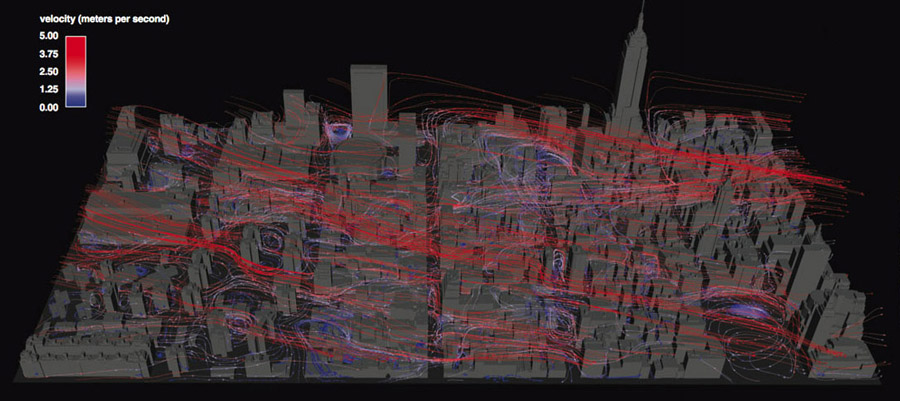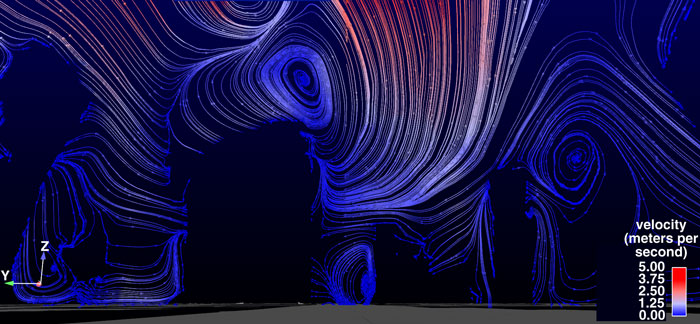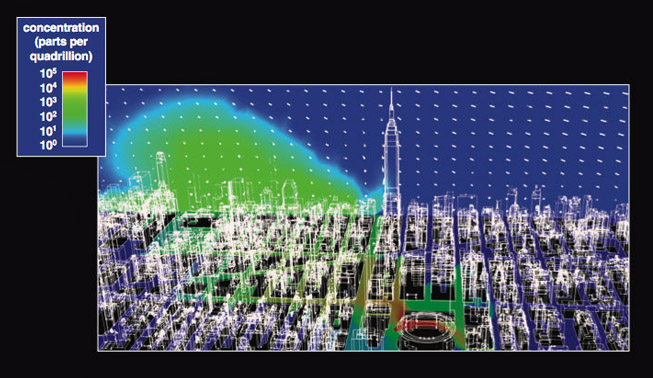Follow the Flow
By Catherine Clabby
Modeling the way air moves around buildings and other objects is a multidimensional challenge
Modeling the way air moves around buildings and other objects is a multidimensional challenge

DOI: 10.1511/2009.79.326
For decades, Alan Huber has appreciated the power of computational fluid dynamics to predict how flows of air interact with objects. He saw it applied first to airplane wings and spacecraft while studying aerospace engineering at the Pennsylvania State University. As a U.S. Environmental Protection Agency researcher, he applied the tool to more complex problems such as predicting how winds might carry pollutants in built environments. Now an adjunct professor with the Institute for the Environment at the University of North Carolina at Chapel Hill, Huber is modeling air flows in no less complex a landscape than downtown Manhattan. At its core, this is a numbers game involving calculations possible only with high-performance computing. But the solutions would be useless, Huber says, without visualizations created by collaborators. Images can portray very complex flow behavior. Examining the modeled flows helps Huber assess the viability of his solutions. Associate Editor Catherine Clabby interviewed Huber about his efforts.

David Borland
American Scientist: Why do we need a numerical simulation of a real environment as complex as Manhattan?
Huber: It’s not possible to measure a full domain the size of Manhattan. If you measure in one spot, you can’t predict what the wind is going to do down the block. In order to understand what happens in these complex streetscapes, you need to create a model. That provides a virtual environment in which we can explore different what-if scenarios and try to understand the processes that occur. We can ask: How can we minimize an adverse environmental effect or maximize the potential for solar energy or for wind power? How should we change the design if we build a new urban area? What would be affected by how we place the buildings and design their shapes?

David Borland
American Scientist: What were the challenges to creating this particular model?
Huber: Manhattan has a lot of complex buildings and no two are alike. First it’s very important to find a source of geometry that represents all the buildings. Fortunately there were applications in the cell-phone industry that generated databases of building geometries. To get a simulation solution, we have to divide a domain up into a number of smaller volumes, which we then assign solutions representing environmental variables there. Because of the complex geometries in a city, we have complex volumes. That doesn’t arise when looking at flow over an airplane wing. You can use a rather uniform mesh of volumes. That was a very large challenge, finding and applying software that would actually develop a mesh made up of volumes that was uniform enough to support stable numerical solutions. The buildings aren’t aerodynamic. There’s a lot of chaos in the flow. And with 54 million cells, you need the computing capacity to solve this.
American Scientist: What resolution have you achieved so far?
Huber: Presently the solutions are in the order of one to four cubic meters. They naturally grow larger as you get away from the building surfaces. We like to have at least 10 volumes across streets, what we call street canyons. That gives enough resolution to capture the main flow features.
American Scientist: How do the visualizations allow you to judge the accuracy of the models?
Huber: Without visualization, I have just a large mass of incomprehensible numbers. I could pick out a few. But that doesn’t show me what’s going on in these complex environments where there are no two points with the same solution.
Having the ability to visualize, I can identify flow behaviors that appear unrealistic. That’s important to capture. In some cases there are real field measurements out there, but in a few isolated points. You want to see patterns around those points.

Wei Tang
American Scientist: What are potential applications for these models?
Huber: Pollution or other harmful substances can be transported by winds, so tracing them is one application. Also, those winds produce forces on building surfaces. If people locate solar panels or wind turbines on buildings, understanding interactions with the wind is very important. This could be helpful in many scenarios where winds are part of a solution, say when an urban planner is designing a new city or adding a new building. They can ask: How does this affect the pattern of winds?
American Scientist: What would you like, one day, to add to the models?
Huber: Presently I simulate the wind. That produces solutions with gigabytes of information. I would like to add additional environmental variables such as solar heat. I’d like to add air chemistry. When you have a mixture of chemicals in an environment such as Manhattan, you have chemical reactions going on. That can change some things. I’d like to consider the thermal impact from the shadowing of different buildings. And I’d like to achieve finer resolution. Adding chemistry and solar energy to the wind may require some finer scales to simulate correctly. But every time you add variability, it takes more computing capacity. Fortunately, with today’s advanced hardware and software, we can begin to tackle this. Also, fortunately, buildings don’t fly and crash. The fine accuracy of my solutions doesn’t have to be the same as those capturing air flow over an airfoil.
Click "American Scientist" to access home page
American Scientist Comments and Discussion
To discuss our articles or comment on them, please share them and tag American Scientist on social media platforms. Here are links to our profiles on Twitter, Facebook, and LinkedIn.
If we re-share your post, we will moderate comments/discussion following our comments policy.